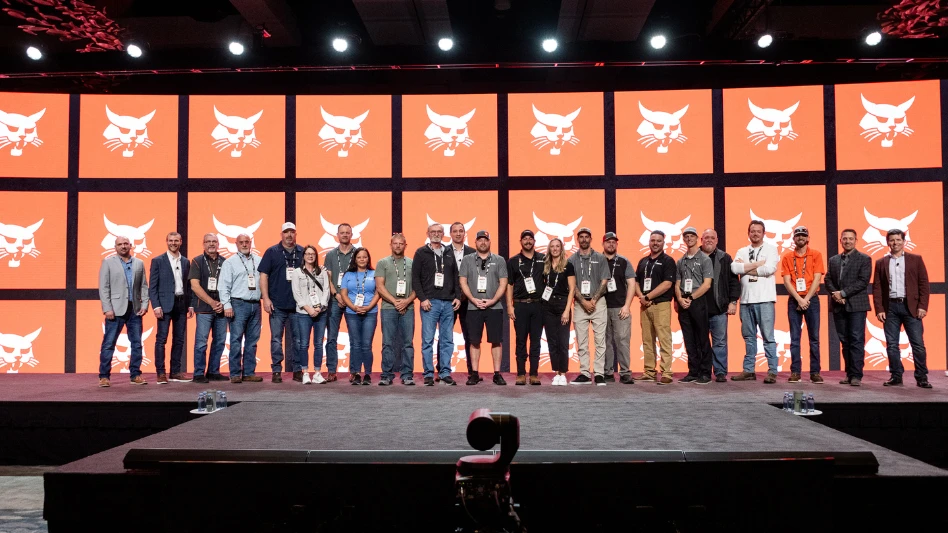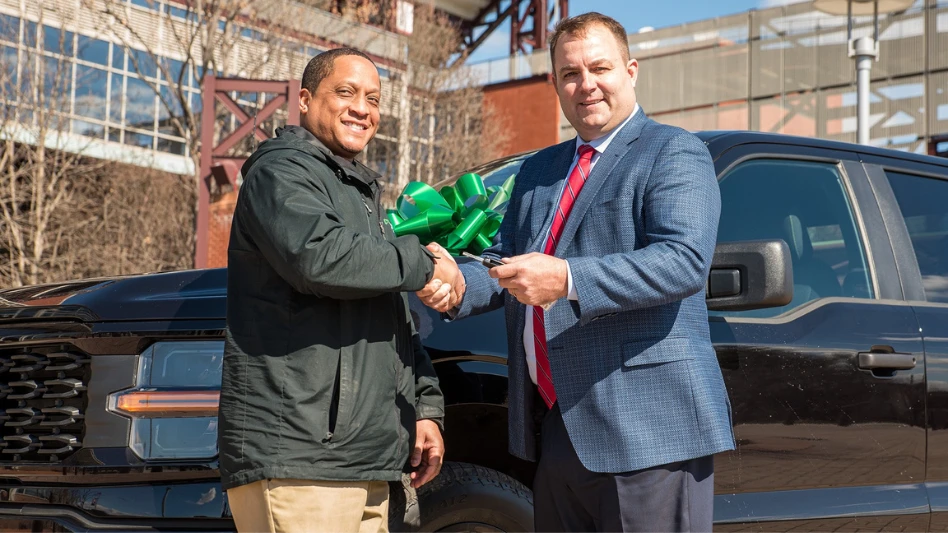Anthony Beaudet remembers the job very well. The owner of Beaudet Earthworks, in Honokaa, Hawaii, was hired to install a small pond on the lower level of an existing office complex. He wondered how he would complete the required excavating and backfill work. The work was too much to try to accomplish by hand. “What machine could he get through the front doors of the office building?” he wondered. The answer came in the form of mini skid-steer.
“It was the only machine that could possibly get through the doors,” Beaudet recalls, describing the feeling of power he got from such a small machine as “awesome.” One mini skid-steer and an operator, he says, easily replaces six workers. “It just was used every day. It definitely paid for itself.”
For Beaudet, the versatility of a mini skid-steer and its many attributes have helped bolster profits by saving money on labor to eliminating potential damage to turf and other surfaces that a mini-skid steer’s larger, heavier brethren can inflict. There are myriad reasons why contractors would opt for using these nimble machines.
Contractors can expect to pay for the versatility and labor-saving abilities of these machines, though they won’t have to break the bank. A machine with a standard bucket ranges between $13,000 to more than $20,000, depending on the attachments. Due to rising steel prices, the units have become a bit more expensive than they have been in the past, manufacturers say. Depending on the fuel platform chosen, the final cost could increase or decrease, as well.
WHY GO MINI? The decreasing size of residential lots in recent years has led to wider need for compact, yet powerful and versatile landscape tools.
“Home builders are maximizing land by placing larger homes on smaller lots and building homes closer together,” says Aaron Kleingartner, loader product specialist for West Fargo, N.D.-based Bobcat Co. “Landscape contractors have less space to maneuver when completing tasks such as grading, sod and irrigation installation, and placing hardscape materials.”
Mini skid-steers can fit between narrowly placed homes, narrow backyard gates and into other confined areas, he says. Plus, since they’re small, they have a light footprint that minimizes or eliminates damage to the job site. Wide tracks ensure flotation that allows the mini skid-steer to work in sandy or muddy conditions.
Because mini skid-steers gain access to confined areas, contractors can mechanize jobs that could only be done by hand before, Kleingartner says. “Instead of hiring two or three extra workers to dig holes for trees and shrubs,” he says, “one operator can mechanize these tasks in half the time with an auger attachment on the mini track loader.”
Many homes in Beaudet’s service area have rock wall foundations that are close together. “There’s no easy access to the backyard,” he says. “If you have a load of soil dropped off in the front yard, the only way to get it to the back is either through a wheel barrow or a mini skid-steer.”
If given a choice, he’ll gladly take the mini skid-steer, Beaudet says.
Mini skid-steers were developed to assist contractors looking for a machine that could help reduce their dependence on labor and bulkier pieces of equipment, says Greg Lawrence, marketing product manager for the Dingo product line of Bloomington, Minn.-based Toro Co.
“Since landscaping requires so many specialty tools to be used at any given time – and the tools can vary from job to job and season to season – the landscape contractor’s fleet is an ideal home for a versatile machine,” he says.
Common mini skid-steer attachments include an auger, trencher, vibratory plow, hydraulic breaker, backhoe, leveler, tiller, cultivator, hydraulic blade, power box rake and more. In addition, attachments such as rotary brooms, hydraulic blades or snow throwers allow contractors to easily expand their offerings to include year-round services.
“On most landscape jobs, there are several small tasks,” Lawrence says. “Mini skid-steer loaders shine in these situations because they are capable of using a variety of attachments in a short amount of time.”
Attachments can quickly be changed out, oftentimes by simply turning two locking pins and connecting hydraulic lines. “They maximize productivity while remaining extremely efficient,” he says.
Though a mini skid-steer doesn’t possess the lifting capacity of its full-size counterpart, the machines are equipped to easily lift materials and perform smaller duties, Kleingartner says. Many mini skid-steers can lift around 550 pounds.
“A contractor might use a mini skid-steer to access a residential backyard to install a retaining wall, trees or an irrigation system,” he says.
The versatility of mini skid-steers enables contractors to carry sod and paving stone, drill holes for trees and fence posts, or install irrigation and drainage systems. Other tasks include grading in a constricted area, digging holes for fence posts, demolishing a concrete patio or steps and sweeping driveways and sidewalks. In addition, the same small frame of a mini skid-steer that allows it to move easily between narrow gates enables it to easily move from job site to job site.
THE RISE OF THE MINI SKID-STEER. Mini skid-steers have become a must-have in some contractors’ arsenals, mostly because of their versatility. While some contractors buy them or lease them outright, the machines are becoming more popular in the rental market. Contractors like using them because many mini skid-steers can utilize the same attachments as larger skid-steers, Kleingartner says. “A hydraulic breaker, for example, may be used with a mini skid-steer, skid-steer loader, compact excavator and loader backhoe.”
Many operators prefer to use walk-behind units over dedicated, ride-on models, Lawrence says.
“This may be because a walk-behind machine is less intimidating than a ride-on machine,” Lawrence says. “This is particularly true in the rental industry, where having a walk-behind machine is important for novice operators not familiar with operating equipment.” But the application and frequency of use will dictate whether a contractor requires a walk-behind or ride-on unit.
“If a contractor is working in confined spaces and is only using the loader here and there, a walk-behind unit may be the most efficient option,” he adds. “However, if the machine is being used for material handling while covering a lot of ground, a ride-on unit may best fit the need.”
Some machines let contractors do both. Some mini skid-steers feature a platform that allows the operator to ride on the machine.
“It helps decrease operator fatigue and increase comfort, especially in applications requiring extensive hauling or covering substantial distances,” Lawrence says. The platform bolts onto the compact utility loader and can be folded up and stored against the machine in a locked position when not in use.
While mini skid-steers come in either gas or diesel fuel platforms, diesel-powered mini skid-steers continue to gain in popularity, Lawrence says. “These units are in demand because diesel engines deliver a flatter torque curve, which gives the operator more usable lugging power at all engine rpm levels,” he says.
Gas units, though, remain a favorite among many contractors, Lawrence adds. The reasons may include the ease of maintenance of a gas-powered unit vs. a diesel unit, fuel availability or perhaps the smaller up-front investment when compared to a diesel machine, Lawrence says.
ATTACHMENTS THAT ARE TOPS. Much like its larger counterpart, attachments truly make the mini skid-steer. Many attachments can often replace dedicated machines for the contractor, which further adds to the machine’s value. But a few are must-haves.
The bucket is essential and can be used for digging, grading and hauling material, Kleingartner says. The trencher is used extensively in landscaping and aids in the installation of irrigation, drainage or electrical lines. Pallet forks allow the operator to easily carry pallets of paving stones, bags of rock, small trees and small amounts of sod, Kleingartner says. Tillers break up hard ground or an area for seeding and when used along with a soil conditioner, a landscaper can easily prepare an area to be seeded, he says.
The soil conditioner provides a smooth, even seedbed to properly grow grass, Kleingartner says. An auger is another useful attachment to drill holes for fence posts, deck post footings, trees or junction boxes in irrigations systems, he says.
These machines have gone beyond just an added efficiency on the job site – they are another way for contractors to expand the number of services they provide to customers, Lawrence says.
For example, many irrigation contractors employ a host of attachments to supplement their fleets and grow their businesses, Lawrence says.
“They use trenchers and vibratory plows for installing pipe, trench fillers for covering open trenches, underground boring units for pulling pipe under driveways and sidewalks, augers for installing valve boxes, and buckets for hauling materials,” Lawrence says. “Other contractors use the backhoe, pallet forks and bucket attachments to build decorative ponds.”

Explore the September 2007 Issue
Check out more from this issue and find your next story to read.
Latest from Lawn & Landscape
- The New World Is Green: Grow With Marketing Analytics & AI
- Exmark launches autonomous commercial mower
- North by Northwest's charitable act for the Ronald McDonald House Charities
- Coxreels expands V-100 Series product line
- Landscape Workshop expands with 2 acquisitions
- Wilson360 adds Daniel Grange as new consultant
- Batman and business
- CH Products releases new tree stabilizer





